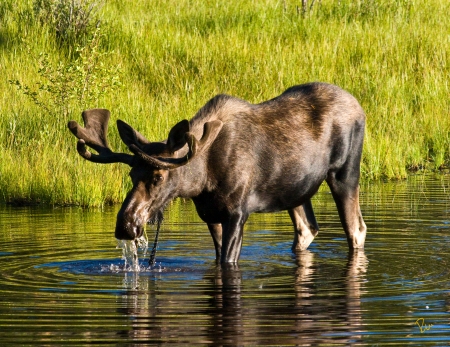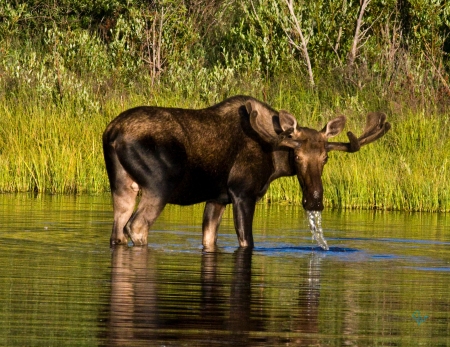It was 4:30 am, an hour before dawn, and I was on my way to 8,200 ft/2500m Sprague Lake in Rocky Mountain National Park. I was drawn by the vision of a sunrise on the Continental Divide reflected in the placid lake. An hour later I was rewarded for the abbreviated snooze. The backdrop (left to right) consists of Taylor Peak, Andrews Glacier, Hallett Peak, Tyndall Glacier, Flattop Mountain and Notchtop Mountain…

Dawn at Sprague Lake
Clearly I was not alone. Those folks in the canoe were looking at a young
bull moose grazing on the other side of the lakebed (look to the left of the canoe at the edge of the shadow in the above photo…look closely…it’s small). So there I went to capture this magnificent sight. I found a suitable hideout in the closest thicket and got this shot…
This was not my first
face-to-face with a bull moose (
Alces alces) and I’m smitten. There is something exceptionally compelling about this big, solitary, mostly peaceful, vegetarian giant of the deer species. This ungainly product of
evolution has survived despite human behaviour at its worst and because of the recent benevolence of humankind. This is is a story of our redemption.
Since being hunted out of Colorado by 1900 their number has recently recovered thanks to a reintroduction program in 1978 and 1979 by the
Colorado Division of Wildlife. Two groups of moose (12 each year) from the Uintah Mountains and Grand Teton herds were transferred to an area just west of the Never Summer Range near Rand, Colorado. The Colorado herd (
estimated to have expanded from the original 24 to nearly 700 in 1994) is scattered over a range that now extends to Winter Park in the south, and Steamboat Springs to the west. In 1980, visitors to Rocky Mountain National Park saw the first members of the herd that had migrated into the
Kawuneeche Valley on the Western side of the Divide. Two thrill seeking cow moose were sighted by rangers on the Continental Divide at the Boulder-Grand Pass just a year later. Since then their numbers are increasing on both sides of the Park. Who knows, this mighty moose might have left the Valley to strike out on his own crossing a 14,000ft/4267m mountain range to do so. Moose are like super deer.
Here are some moose facts…
–Here in Colorado we have a subspecies called
Shiras moose (Alces alces shirasi) which are the smallest of the subspecies of moose. They are also known as Yellowstone or Wyoming moose.
–Shiras Moose are the largest mammals of the Rocky Mountains.
–The moose has a very thick, strong neck from which hangs a long, round flap of skin and hair called a
dewlap, or bell. This varies in appearance from moose to moose and occurs in both the male and female of the species. Some dewlaps are fat and up to 20 inches long; some are short and thin; and some others may just be a tuft a hair. Bull moose have been observed contorting their bodies in order to urinate on their dewlap, thereby soaking it in their pheromone-rich urine. It drives the cows mad!
–The moose has a top speed of 35 miles (55 kilometers) per hour. Those long spindly legs work well in snow and water too.
–Moose are loners by nature and these largest members of the deer family rarely travel with more than one or two other moose companions.
–Over a 20-year life span in the wild, bulls may reach a height of 6½ to 7½ feet (2-2.3 m) at the shoulder, and weigh from 800 – 1,600 pounds (360-725 kg). Cow moose are only slightly less imposing at 5 to 6½ feet (1.5-2 m) tall and 600 – 1,000 pounds (270-450 kg).
–Both mature males and females can be extremely unpredictable. Rutting bull moose have charged horses, cars, and locomotives. The female is particularly protective of her calf.
–The moose is a
herbivore and is capable of consuming many types of plants and fruits. The average adult moose needs to consume almost 10 thousand calories per day to maintain its body weight.
–Much of a moose’s energy is derived from terrestrial vegetation, mainly consisting of non-grasses, and fresh shoots from trees such as willow and birch. These plants are rather low in sodium, and moose generally need to consume a good quantity of aquatic plants. While much lower in energy, these plants provide the moose with its sodium requirements, and as much as half of their diet usually consists of aquatic plant life.
Here are some more photos from my lakeside hideout…
That’s All Folks! ©Bullwinkle Studios






